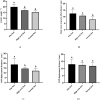Risk factors and foot biomechanical characteristics of idiopathic scoliosis: a cross-sectional study
- PMID: 40374734
- PMCID: PMC12081873
- DOI: 10.1038/s41598-025-01170-4
Risk factors and foot biomechanical characteristics of idiopathic scoliosis: a cross-sectional study
Abstract
Idiopathic scoliosis (IS) caused by an unknown etiology is prevalent in primary and secondary school students. Early detection and prevention are challenging because of the limited knowledge about controllable risk factors and imbalances in body mechanics. In this study, we examined the potential causative factors of IS and its correlation with foot mechanics among 7-14 year-old students in northern Jiangsu Province, China. Based on a stratified whole cluster sampling, 4387 students were examined, of whom of whom 165 were diagnosed with scoliosis. Through logistic regression analysis, the following risk factors were identified: age group, female gender, thinness, unsuitable desk and chair heights, heavy schoolbags, backpack carried on one shoulder, daily sedentary time ≥ 10 h, daily playing electronic products time ≥ 2 h, daily physical activity time < 1 h, sports programs with unilateral limb power, lumbar and back fatigue, unequal thickness of worn soles on both feet and flat foot. When compared to healthy people, IS patients exhibit foot biomechanics characterized by a diagonal distribution of bilateral weight-bearing and walking instability, as well as poor balance function if they have an abnormal foot type, as in the case of flat foot. Our study revealed that the detection rate of scoliosis in primary and secondary school students in northern Jiangsu Province, China, is relatively is on the high side, so it is necessary to strengthen education and screening, concentrate on female students, and provide guidance on how to develop a healthy lifestyle and learning habits. Assessment of plantar pressure distribution and postural symmetry is an effective means of predicting scoliosis. Plantar pressure analysis can serve as an additional tool for assessing the risk of scoliosis.
Keywords: Epidemiology; Foot biomechanics; Idiopathic scoliosis; Primary and secondary school students; Risk factors.
© 2025. The Author(s).
Conflict of interest statement
Declarations. Competing interests: The authors declare no competing interests. Ethics committee approval: This study was approved by the ethics committee of the Affiliated Hospital of Nanjing University of Traditional Chinese Medicine (NO. 2024NL-038-02). Consent for publication: Informed consent was obtained from all the participants.
Figures





Similar articles
-
Modifiable factors affecting the development of adolescent idiopathic scoliosis in Chinese students: insights from a questionnaire survey on abnormal performance.BMC Public Health. 2025 Apr 22;25(1):1489. doi: 10.1186/s12889-025-22666-8. BMC Public Health. 2025. PMID: 40264024 Free PMC article.
-
Influence of curve location and type of adolescent idiopathic scoliosis on static and dynamic plantar pressure.Gait Posture. 2025 Jun;119:39-47. doi: 10.1016/j.gaitpost.2025.02.014. Epub 2025 Feb 17. Gait Posture. 2025. PMID: 40020270
-
Positive rate and influencing factors of adolescent idiopathic scoliosis among school children aged 9 to 18 years in Xiamen, China.BMC Pediatr. 2025 Mar 19;25(1):216. doi: 10.1186/s12887-025-05566-z. BMC Pediatr. 2025. PMID: 40108585 Free PMC article.
-
Severity of spine malalignment on center of pressure progression during level walking in subjects with adolescent idiopathic scoliosis.Annu Int Conf IEEE Eng Med Biol Soc. 2014;2014:5888-91. doi: 10.1109/EMBC.2014.6944968. Annu Int Conf IEEE Eng Med Biol Soc. 2014. PMID: 25571336 Review.
-
Biomechanical factors in the progression of idiopathic scoliosis.Ann Biomed Eng. 1984;12(6):621-30. doi: 10.1007/BF02371453. Ann Biomed Eng. 1984. PMID: 6398636 Review.
Cited by
-
Enhancing national fitness legislation in the context of promoting a healthy China.Front Sports Act Living. 2025 Jul 7;7:1598339. doi: 10.3389/fspor.2025.1598339. eCollection 2025. Front Sports Act Living. 2025. PMID: 40692845 Free PMC article. Review.
References
-
- Hengwei, F. et al. Prevalence of idiopathic scoliosis in Chinese schoolchildren: A large, population-based study. Spine (Phila Pa 1976)41, 259–264 (2016). - PubMed
MeSH terms
LinkOut - more resources
Full Text Sources
Medical

